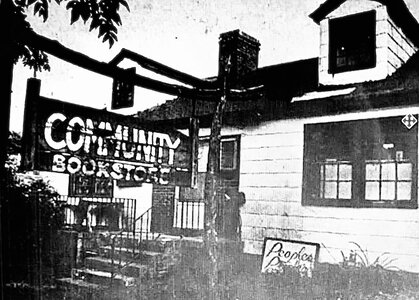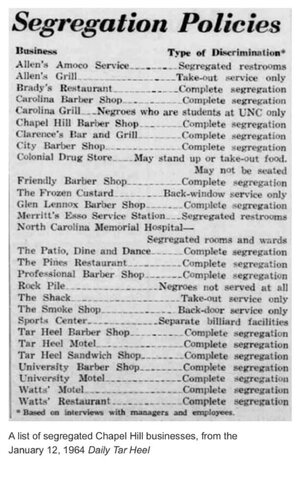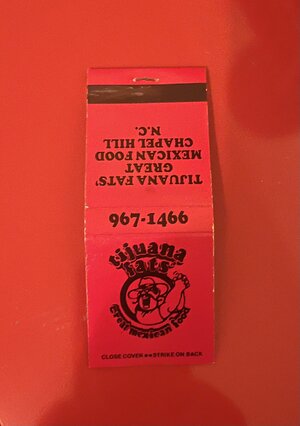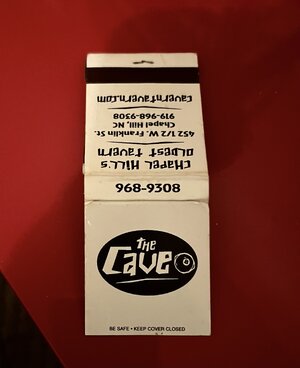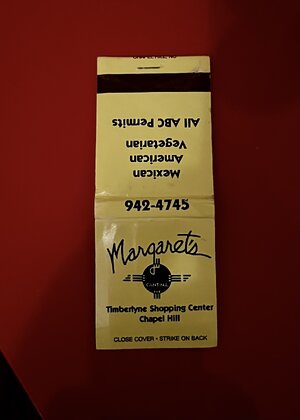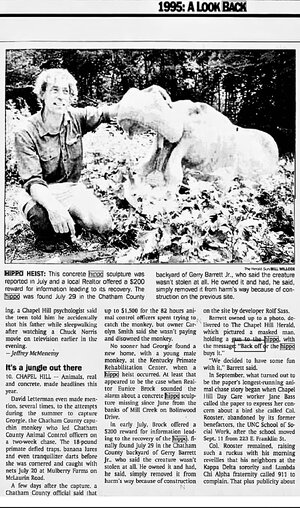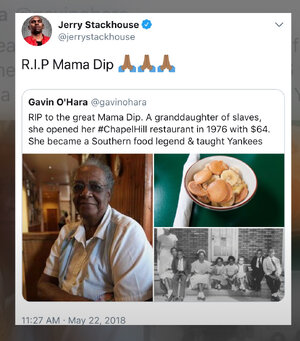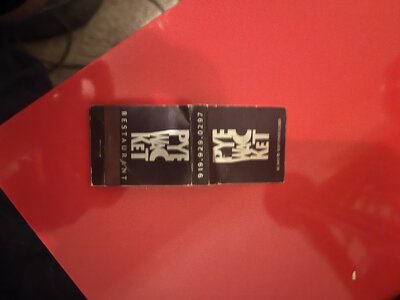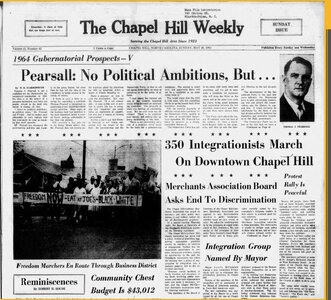I'd drop by occasionally on my way to the back door of the Cave.
Navigation
Install the app
How to install the app on iOS
Follow along with the video below to see how to install our site as a web app on your home screen.
Note: This feature may not be available in some browsers.
More options
You are using an out of date browser. It may not display this or other websites correctly.
You should upgrade or use an alternative browser.
You should upgrade or use an alternative browser.
Chapel Hill/Carrboro History
- Thread starter nycfan
- Start date
- Replies: 807
- Views: 17K
- Off-Topic
donbosco
Inconceivable Member
- Messages
- 3,400

‘Capital of the Southern Mind’
By Peter Range, Dec. 17, 1972, New York Times
Chapel Hill NC — This is the kind of town where an alderperson
(that is, a lady alderman) lofts a helium filled balloon above
the main street on a 90‐foot string to dramatize the visual
damage that would be done if the zoning board approved a
bank's plan to construct a 9‐story building in the center of
an otherwise two‐story town. She helped get the building cut
down to 3 stories.
It's also a town where a 72‐year‐old retired investment
banker, Robert Hudgens, thunders forth at irregular intervals
with editorials on the Vietnam war, the Men's Garden Club or
the promise of youth. He writes, hand‐sets, prints & mails
the editorials out to friends from a basement printshop he
calls The Rooster Press of Chapel Hill. “Everybody here tends
to take you at face value,” Hudgens says. “You can be in
violent disagreement with your neighbor & it doesn't matter.
You can mow your lawn on Sunday & the people who go to church
don't pay any attention.”
Chapel Hill's tradition of individuality & intellectual
ferment is consistent with what has always been its principal
industry: higher education. The University of North Carolina,
which is in the town & is often called, simply, “Chapel Hill,”
was the first state university in the US & has been a leading
educational institution since it was opened in 1795.
Chapel Hill is in the rolling Piedmont region at the center
of the state. One of its blessings is isolation: it's 10 miles
from the nearest city, Durham, a swampy 30 miles from the
state capital, Raleigh, & 12 miles of pastureland from the
tiny county seat of Hillsboro. The old campus of the
university, much like a well‐done but casual English garden,
is the heart of Chapel Hill. Thomas Wolfe, a student there
from 1916-1920, described it in “Look Homeward, Angel”: “The
university was a charming, an unforgettable place...buried
in a pastoral wilderness.... The central campus sloped back
& up over a broad area of rich turf, groved with magnificent
ancient trees.”
Boost the Spirit
-----------------
Overrun with cherry trees, dogwood & hardwoods hung with
wisteria, Chapel Hill has brilliant springs & misty autumns
that do something for the spirit. Meticulously laid brick
walks crisscross the university's undulating grounds with
their hodgepodge of old brick buildings, but the grass
clearly invites you to walk, sit, read or play on it. And
everybody does. It's never surprising to see a graduate
seminar or even an overcrowded freshman class meeting out
of doors under one of the hundreds of oaks & maples. In the
evening sitters or strollers enjoy their own private recitals
outside the practice rooms of the music department. A reverie
may be interrupted by meandering children, dogs & young
lovers, but it's all part of the background, & mildly,
pleasantly distracting.
The campus is a very open one, flowing naturally over a
low rock wall onto the one‐block hub of downtown. Academe &
commerce do not collide here.
Like any university community, Chapel Hill has its town &
gown rifts, but because the rather cosmopolitan academic
community is at least as large as the homegrown business
& farm population, a modus vivendi was reached long ago.
Except for a brief upheaval at the height of the civil
rights movement, the good God-fearing folk of Chapel Hill
& the surrounding farmland maintain a friendly respect for
all of the hairy, book‐toting atheists in their midst &
the intellectual community has less arrogant scorn for its
non‐academic, more fundamentalist neighbors than any
assemblage of eggheads east of the Iowa Writers Workshop.
The modus vivendi extends even to political power, which is
a shared thing. Aldermanic seats are more or less evenly
divided between town & gown; 2 of the 6 aldermen are women,
& while Chapel Hill has a very small black population for
a Southern town (only 10% of the 25,537 inhabitants are
black), its mayor is Howard Lee, a black medical career
adviser at arch‐rival Duke 10 miles away. In his 2nd race
Lee carried every precinct by an overwhelming margin.
Writers, editors, social & political scientists have come
to The Hill to study, work, teach & live.
For many decades the only liberal enclave in a vehemently
conservative South, Chapel Hill was the natural gathering
spot for young Southerners looking for a Harvard within a
day's railroad ride. At the turn of the century, philosopher
& gadfly Horace Williams was the town's intellectual dynamo
& the man who started it on its more or less permanent
ideological collision course with a state legislature
dominated to this day by tobacco & textile interests. As a
student, Thomas Wolfe helped make the outspoken, six‐day‐a‐
week campus newspaper, The Daily Tar Heel, the pushy force
for change that it has become. Dramaturgist Frederick Koch
created in the Carolina Playmakers the best Southern
university theater company outside Tulane University. The
Playmakers gave Wolfe his first playwriting experience &
actors like Jack Palance & Andy Griffith their early
exposure to greasepaint.
Chapel Hill sociologist Howard Odum, Dixie's answer to
Gunnar Myrdal, undertook the first major regional study
of the South with his 1936 work, “Southern Regions of the
United States,” which graphically portrayed an impoverished,
prejudice‐bound South on the threshold of its own industrial
revolution. This approach is now being carried on by a
group of intellectuals called the L.Q.C. Lamar Society,
whose current guiding light is Chapel Hill alumnus Terry
Sanford, former Governor & now president of Duke University.
Words are the currency in academe; writers & editors have
always been drawn to Chapel Hill, whether to begin their
careers, pursue them or retire from them. Betty Smith (“A
Tree Grows in Brooklyn”) came to Chapel Hill for a visit
in 1935 & never left until her death last year. Novelists
Leon Rooke, John Ehle, Robert Ruark, Noel Houston & James
Street all thrived in or around Chapel Hill. John Knowles,
after the success of “A Separate Peace,” spent a fructuous
year in Chapel Hill as a writer‐in‐residence.
Playwright Paul Green & short‐story writer Max Steele still
work here. Journalists like C.B.S's Charles Kuralt & The
New York Times' Clifton Daniel, Tom Wicker & Wayne King
all graduated from the university. Gene Roberts, a former
Times man & now managing editor of The Philadelphia
Inquirer, is a Chapel Hill alumnus.
It's no accident that two of the deservedly respected
elders of American journalism, Mark Ethridge of The
Louisville Courier‐Journal & Vermont Royster of The Wall St.
Journal, have chosen to spend their active retirement in
Chapel Hill. They are wise & gentle men who have relin-
quished editorships to renew intimate contact with the
young when lesser men would decline in inactivity. Ethridge,
who built a home here with his writing wife, Willie Snow
Ethridge, calls Chapel Hill “the capital of the Southern mind.”
Chapel Hill has produced a marvelous melding of the
intellectual vigor of youth & the wisdom of longevity.
Professors still commonly practice old school, Mr. Chips
techniques, holding seminars or end‐of‐semester partied for
their students at home.
Cont. in next post.
donbosco
Inconceivable Member
- Messages
- 3,400
The favorite pastime is to talk & a favorite hangout is a bookstore.
In Chapel Hill a favorite pastime is talk, be it metaphysics
or gossip, & the crowded walk in front of the little post
office is a favorite meeting place. “On Saturday mornings
I go to Fowler's Food Market & the post office so I can see
everyone I missed during the week,” says Anne Queen, who is
director of the campus Y.M.C.A. program but whose primary
role in town is that of gadfly & latter‐day salon keeper
for Chapel Hill's rarified egghead community. Many waves of
young intellectuals have been introduced to that community
at Anne's Sunday morn ing sherry brunches in her cottage
on a lane off Mallette Street. Political & literary guests
often enliven the discussions. Politicans like Mike
Mansfield, Bella Abzug & Allard Lowenstein were there this
year. So was Norman Mailer. Ms. Queen had grits for him &
“he almost licked his plate.”
A favorite nighttime hangout is the Intimate Bookshop, a
high‐ceilinged emporium with creaking floors, 1950s music
from the owner's private record collection, a children's
nook replete with tiny, battered reading chairs, & no less
than 40,000 books in stock. It's one of the few places open
at night & browsers are always welcome. “Once in a while
someone lies down in a cubicle to read for several hours &
we let him stay until he gets in the way,” says proprietor
Wally Kuralt, brother of CBS's Charles.
“The flower ladies” are another of downtown's primary
attractions. Though a city hall disagreement over what to
do about proliferating leather & jewelry sales on the
sidewalks by assorted artisans & freaks forced the flower
ladies off the main walk into a passageway, a half‐dozen
or so black women in billowy cotton dresses still do a
brisk business in fresh‐cut flowers almost every day of the
year. The flowers have gone up from 35 cents 10 years ago
to $1 a bunch now, but they're still sold from old coffee
cans & wrapped in yesterday's newspaper.
Rosa Belle Stone, one of the flower ladies, has withstood
the elements & watched the sidewalk parade for 35 years,
“since I was 8 years old.” She remembers carrying 5‐cent
bunches of flowers as a little girl to the late Dr. Frank
Porter Graham, university president, US Senator, UN mediator
& general guiding light of Chapel Hill liberals. She cherishes
the memory of “one lady who gave me a beautiful doll, some-
thing I'd never been able to have.” And she remembers one
white customer “who came up one day & said, ‘You know, you're
the reason I made up my mind to settle in Chapel Hill.’” In
another place that incident might carry a tinge of racial
condescension, but in Chapel Hill it is a highly believable
story, for Chapel Hillians are the sort of people to make a
lifelong decision for that kind of reason.
Consider Jorgen Petersen, a Danish industrial engineer who
was searching for a new life after 10 years in the Rhodesian
copper mines & 5 more with Chrysler in Detroit & California.
“We rode down main street & people were walking!” he exclaims.
“You know, In the cities, nobody walks, they drive. But here
people were walking in the business district. So I thought,
here may be the place.” It was, & the Petersens now operate
a very popular Danish open‐sandwich cafe just one block off
the main street.
Another immigrant was Edward Danziger, a Viennese Jewish
refugee who in 1939 was looking for the proper outlet for
his talents as chef & candymaker. Though “Papa D,” as he came
to be known, died last year, his Old World Gift Shop in the
center of town is still aclutter not only with rich
confections but also with imported crystal, European woods
& yellowed clippings proclaiming first the Anschluss & then
the fall of the Third Reich.
There's little concern about wealth in Chapel Hill. There
may be a millionaire or two within the city limits, but they
are impossible to spot. Cadillacs are almost unheard of;
those seeking expensive comfort turn to a Mercedes instead
(Chapel Hill has a European bias, anyway). Ostentation is
abhorred second only to intellectual vapidity. The town
fairly exudes classlessness & is utterly bereft of anything
even vaguely smacking of haut monde. The one attempt at a
country club was a bust.
There are some people who think Chapel Hill is changing for
the worse. The town's population has tripled in the last
20 years & the university's student body has grown to 18,000.
In a community where everyone used to come out to see the
automobile accident, traffic has become strangulating &
accidents common.
“Anybody who knew the old Chapel Hill knows it's gone to
hell,” says James Shumaker, the editor of what used to be
The Chapel Hill Weekly. “There's too much of everything.
Too many people, too many cars.” It's perhaps a sign of the
town's alleged ruination that the Weekly is now called The
Chapel Hill Newspaper & is publishing 4 times a week.
Obviously a commercial decision, for Chapel Hill hardly
produces that much news.
Most of whatever ruination has occurred has been, thankfully,
at the bottom of The Hill (Wolfe called it “a long tabling
butte, which rose steeply above the country”). That's where
the motel blight is. But unfortunately there has been
encroachment upon The Hill, too: a couple of hamburger stands,
look alike high‐rise dormitories put up by private capital
to house the growing student population, tasteless boxy apart-
ment houses, an out‐of‐proportion & gargantuan new chemistry
building. Hardee's Hamburgers feeds the motor bike & loud‐
muffler set where a tiny brook used to drive a miniature
water‐wheel surrounded by several Gartenzwerge (German garden
dwarfs) in front of a simple old frame house. The customers
at Belles department store across the street park on asphalt
where two widows used to sit on their long front porch.
And more than the scenery has deteriorated. In the mid‐60s
the town's first murder in memory was committed, in the
arboretum, the romantic botanical gardens near the women's
dorms where all local love affairs were traditionally begun,
consummated & ended. Yes, it was a young white coed, killed
in broad daylight. And yes, to make complete the cliche
preoccupation of the outside world, a “large black male” was
reported to have fled from the scene. Chapel Hill was not
used to this kind of thing. The murder has never been solved,
but garish mercury vapor burners were forthwith installed in
the stolid old milkglass lampposts that dot the campus.
Coeds are counseled not to walk without escort after dark
now, a normal precaution almost anywhere but Chapel Hill.
In August, Chapel Hill also had its first recorded bank
robbery. It's perhaps a measure of things that the perpe-
trators could bag only $2,500. Still, few people in Chapel
Hill bother to lock their cars or front doors.
On every return to Chapel Hill, especially after a long
absence, one anticipates the worst. And indeed, inevitably
one finds yet another shopping center in place of acres of
trees on the edge of town, still more concessions to the
internal combustion engine downtown & too many people every-
where. But one is always startled, in an honestly breath-
taking way, by the patient, unaltered beauty of the old town
& the indomitably intellectual spirit of the people.
“Chapel Hill is like an old lady who won't be looked down
the nose at,” says Robert Hudgens.
Maybe it's the graveled walks of East Franklin Street, or
perhaps the perennial presence of Grand Old Man Robert House,
the classicist & former university chancellor who never
misses his predawn constitutional, or maybe simply the daily
holiday atmosphere of the main business block: There remains
a magical, vibrant village charm.
The danger of provincialism is therefore present, & Chapel
Hill is provincial about some things: like fighting for
months to preserve a single rather insignificant tree that
the road builders wanted to cut down, or standing in the
way of the kind of progress the bank's architect had in
mind with his 9‐story building. But the town is too cosmo-
politan for serious parochialism. It would be hard io go
to lunch with 5 people in Chapel Hill without finding out
that at least two of them had just returned from, say,
Paris, Uganda or at least New York. Chapel Hill may be the
only Southern town with pre‐breakfast doorstep delivery of
the Sunday. New York Times (280 of them & 800 more at news-
stands). It's taken quite for granted here that one knows
what is happening on the broad American cultural scene.
December 17, 1972, New York Times.
In Chapel Hill a favorite pastime is talk, be it metaphysics
or gossip, & the crowded walk in front of the little post
office is a favorite meeting place. “On Saturday mornings
I go to Fowler's Food Market & the post office so I can see
everyone I missed during the week,” says Anne Queen, who is
director of the campus Y.M.C.A. program but whose primary
role in town is that of gadfly & latter‐day salon keeper
for Chapel Hill's rarified egghead community. Many waves of
young intellectuals have been introduced to that community
at Anne's Sunday morn ing sherry brunches in her cottage
on a lane off Mallette Street. Political & literary guests
often enliven the discussions. Politicans like Mike
Mansfield, Bella Abzug & Allard Lowenstein were there this
year. So was Norman Mailer. Ms. Queen had grits for him &
“he almost licked his plate.”
A favorite nighttime hangout is the Intimate Bookshop, a
high‐ceilinged emporium with creaking floors, 1950s music
from the owner's private record collection, a children's
nook replete with tiny, battered reading chairs, & no less
than 40,000 books in stock. It's one of the few places open
at night & browsers are always welcome. “Once in a while
someone lies down in a cubicle to read for several hours &
we let him stay until he gets in the way,” says proprietor
Wally Kuralt, brother of CBS's Charles.
“The flower ladies” are another of downtown's primary
attractions. Though a city hall disagreement over what to
do about proliferating leather & jewelry sales on the
sidewalks by assorted artisans & freaks forced the flower
ladies off the main walk into a passageway, a half‐dozen
or so black women in billowy cotton dresses still do a
brisk business in fresh‐cut flowers almost every day of the
year. The flowers have gone up from 35 cents 10 years ago
to $1 a bunch now, but they're still sold from old coffee
cans & wrapped in yesterday's newspaper.
Rosa Belle Stone, one of the flower ladies, has withstood
the elements & watched the sidewalk parade for 35 years,
“since I was 8 years old.” She remembers carrying 5‐cent
bunches of flowers as a little girl to the late Dr. Frank
Porter Graham, university president, US Senator, UN mediator
& general guiding light of Chapel Hill liberals. She cherishes
the memory of “one lady who gave me a beautiful doll, some-
thing I'd never been able to have.” And she remembers one
white customer “who came up one day & said, ‘You know, you're
the reason I made up my mind to settle in Chapel Hill.’” In
another place that incident might carry a tinge of racial
condescension, but in Chapel Hill it is a highly believable
story, for Chapel Hillians are the sort of people to make a
lifelong decision for that kind of reason.
Consider Jorgen Petersen, a Danish industrial engineer who
was searching for a new life after 10 years in the Rhodesian
copper mines & 5 more with Chrysler in Detroit & California.
“We rode down main street & people were walking!” he exclaims.
“You know, In the cities, nobody walks, they drive. But here
people were walking in the business district. So I thought,
here may be the place.” It was, & the Petersens now operate
a very popular Danish open‐sandwich cafe just one block off
the main street.
Another immigrant was Edward Danziger, a Viennese Jewish
refugee who in 1939 was looking for the proper outlet for
his talents as chef & candymaker. Though “Papa D,” as he came
to be known, died last year, his Old World Gift Shop in the
center of town is still aclutter not only with rich
confections but also with imported crystal, European woods
& yellowed clippings proclaiming first the Anschluss & then
the fall of the Third Reich.
There's little concern about wealth in Chapel Hill. There
may be a millionaire or two within the city limits, but they
are impossible to spot. Cadillacs are almost unheard of;
those seeking expensive comfort turn to a Mercedes instead
(Chapel Hill has a European bias, anyway). Ostentation is
abhorred second only to intellectual vapidity. The town
fairly exudes classlessness & is utterly bereft of anything
even vaguely smacking of haut monde. The one attempt at a
country club was a bust.
There are some people who think Chapel Hill is changing for
the worse. The town's population has tripled in the last
20 years & the university's student body has grown to 18,000.
In a community where everyone used to come out to see the
automobile accident, traffic has become strangulating &
accidents common.
“Anybody who knew the old Chapel Hill knows it's gone to
hell,” says James Shumaker, the editor of what used to be
The Chapel Hill Weekly. “There's too much of everything.
Too many people, too many cars.” It's perhaps a sign of the
town's alleged ruination that the Weekly is now called The
Chapel Hill Newspaper & is publishing 4 times a week.
Obviously a commercial decision, for Chapel Hill hardly
produces that much news.
Most of whatever ruination has occurred has been, thankfully,
at the bottom of The Hill (Wolfe called it “a long tabling
butte, which rose steeply above the country”). That's where
the motel blight is. But unfortunately there has been
encroachment upon The Hill, too: a couple of hamburger stands,
look alike high‐rise dormitories put up by private capital
to house the growing student population, tasteless boxy apart-
ment houses, an out‐of‐proportion & gargantuan new chemistry
building. Hardee's Hamburgers feeds the motor bike & loud‐
muffler set where a tiny brook used to drive a miniature
water‐wheel surrounded by several Gartenzwerge (German garden
dwarfs) in front of a simple old frame house. The customers
at Belles department store across the street park on asphalt
where two widows used to sit on their long front porch.
And more than the scenery has deteriorated. In the mid‐60s
the town's first murder in memory was committed, in the
arboretum, the romantic botanical gardens near the women's
dorms where all local love affairs were traditionally begun,
consummated & ended. Yes, it was a young white coed, killed
in broad daylight. And yes, to make complete the cliche
preoccupation of the outside world, a “large black male” was
reported to have fled from the scene. Chapel Hill was not
used to this kind of thing. The murder has never been solved,
but garish mercury vapor burners were forthwith installed in
the stolid old milkglass lampposts that dot the campus.
Coeds are counseled not to walk without escort after dark
now, a normal precaution almost anywhere but Chapel Hill.
In August, Chapel Hill also had its first recorded bank
robbery. It's perhaps a measure of things that the perpe-
trators could bag only $2,500. Still, few people in Chapel
Hill bother to lock their cars or front doors.
On every return to Chapel Hill, especially after a long
absence, one anticipates the worst. And indeed, inevitably
one finds yet another shopping center in place of acres of
trees on the edge of town, still more concessions to the
internal combustion engine downtown & too many people every-
where. But one is always startled, in an honestly breath-
taking way, by the patient, unaltered beauty of the old town
& the indomitably intellectual spirit of the people.
“Chapel Hill is like an old lady who won't be looked down
the nose at,” says Robert Hudgens.
Maybe it's the graveled walks of East Franklin Street, or
perhaps the perennial presence of Grand Old Man Robert House,
the classicist & former university chancellor who never
misses his predawn constitutional, or maybe simply the daily
holiday atmosphere of the main business block: There remains
a magical, vibrant village charm.
The danger of provincialism is therefore present, & Chapel
Hill is provincial about some things: like fighting for
months to preserve a single rather insignificant tree that
the road builders wanted to cut down, or standing in the
way of the kind of progress the bank's architect had in
mind with his 9‐story building. But the town is too cosmo-
politan for serious parochialism. It would be hard io go
to lunch with 5 people in Chapel Hill without finding out
that at least two of them had just returned from, say,
Paris, Uganda or at least New York. Chapel Hill may be the
only Southern town with pre‐breakfast doorstep delivery of
the Sunday. New York Times (280 of them & 800 more at news-
stands). It's taken quite for granted here that one knows
what is happening on the broad American cultural scene.
December 17, 1972, New York Times.
Last edited:
- Messages
- 2,453
Jan 12, 1964 Durham to Chapel Hill March to try and end segregation Donbosco has previously posted some links to John Ehles writing on such subjects
donbosco
Inconceivable Member
- Messages
- 3,400

Matt Barrett's Tales from the Rock and Roll Crypt
Matt Barrett's collection of stories from his days as a musician in Chapel Hill, North Carolina and Greece
www.mattbarrett.net
I think I might still have one or two of those in a dresser drawer. I do have a "stolen from the Cave" ashtray and a coffee cup.
donbosco
Inconceivable Member
- Messages
- 3,400
I think I might still have one or two of those in a dresser drawer. I do have a "stolen from the Cave" ashtray and a coffee cup.
Ah ashtrays and matchbooks...true artifacts of days gone by.
donbosco
Inconceivable Member
- Messages
- 3,400
And another Chapel Hill Animal Tale!!
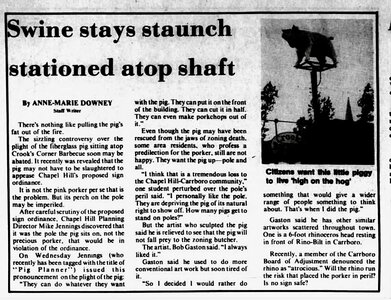
I had a vague memory of this controversy over The Crook’s Corner Pig on a Pole. What I also remember of Crook’s in those days had a bit different, can I say it? New Wave BBQ Vibe in those days? Who else has remembering on this? (Daily Tar Heel, January 18, 1980)

I had a vague memory of this controversy over The Crook’s Corner Pig on a Pole. What I also remember of Crook’s in those days had a bit different, can I say it? New Wave BBQ Vibe in those days? Who else has remembering on this? (Daily Tar Heel, January 18, 1980)
Iirc, it was an Arkansas style that wasn't very good. Cam Hill was an investor,I'm pretty sure and I don't remember who else. Cam was also the owner of Rhino-bilt, later changed to Cleora Sterling and had two full sized rhinos made from fiberglass made by Bob Gaston at his house on the corner of Cameron Ave., now a parking lot.And another Chapel Hill Animal Tale!!
I had a vague memory of this controversy over The Crook’s Corner Pig on a Pole. What I also remember of Crook’s in those days had a bit different, can I say it? New Wave BBQ Vibe in those days? Who else has remembering on this? (Daily Tar Heel, January 18, 1980)
I worked with Bob in what was originally the King's Klub at the Hotel Europa. He was called in to paint some concrete columns in a faux marble pattern and I was running oak rail caps and Corian baseboard.
My mother was definitely born in the South. She DID NOT cook.
We NEVER ate grits or fried chicken. Or mashed potatoes. Ever.
Pork chops with applesauce was as close to fine dining as we reached
.
donbosco
Inconceivable Member
- Messages
- 3,400
My mother was definitely born in the South. She DID NOT cook.
We NEVER ate grits or fried chicken. Or mashed potatoes. Ever.
Pork chops with applesauce was as close to fine dining as we reached
.
My Momma was rural southern and had 7 sisters. Her mother was a good cook but apparently she only taught each of her daughters to cook one thing well. My mother learned "stew beef." She burned pretty much everything else but lots of southern dishes tend to be cooked to death any way so that worked out. I learned early on in life that if I didn't want crusty biscuits that I needed to hang out in the kitchen and pull them myself. I had to keep an eye on the gravy too.
My mom mostly learned to cook mostly from my dad's mom after my dad was killed and we moved in with them. Her mom was dead, her dad had remarried and she had six sisters living at home. Their kids were all gone so that's where we went. Mom had never lived with her parents, anyway and didn't associate with them much until she was widowed. She never talked too much about her life with her foster parents but it must not have been to bad. We visited them occasionally later.
Mama (my dad's mom) was a great cook. Didn't do anything but country cooking but she did that well. Hell I was 18 before I discovered that I most disliked vegetables. Mom and my Aunt Thelma both cooked just like her.
Mama (my dad's mom) was a great cook. Didn't do anything but country cooking but she did that well. Hell I was 18 before I discovered that I most disliked vegetables. Mom and my Aunt Thelma both cooked just like her.
Share:

